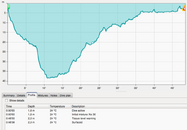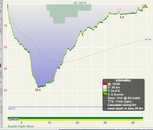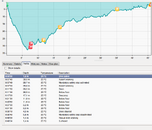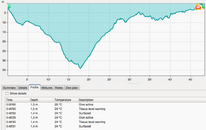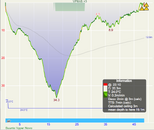I am either confused or unhappy (don’t know yet) as to how my diving computer passes information to me about potential need for decompression
I downloaded all my dives to Subsurface, and according to calculations based on the deco algorithms that Subsurface includes, there was a ceiling for several of my dives.
I was surprised, as I thought that my computer, using the supposedly more conservative RGBM algorithm (vs. the VPM-B and Buhlman algorithms in Subsurface) and also programmed to a more conservative personal setting would show me that information.
I am absolutely sure that the computer did not show any such information on those specific dives. I am familiar with how my Vyper Novo shows such information, because in one dive I had a deco obligation and the computer guided me above the required floor, then just under the deco ceiling and was counting down minutes to clear me from deco.
So, I wonder what is the source of this discrepancy. Could it be that my computer was aware of that ceiling but it assumed that deco would clear as I would progressively reduce my depth on my way back? Now my confusion (or problem) is the following: was there indeed a deco ceiling in those dives that I was unaware of? Or is it that the Subsurface algorithms are even more conservative than Suunto’s? I have no tec training, and I am not familiar with the different deco algorithms, so I asking here. I bought the Suunto based on recommendations that it is probably the most conservative for recreational diving. So, what happens here?
Secondly, if indeed there was a deco ceiling, how the Suunto assumed that it would clear because a normal slow-lengthy ascent would happen in the future minutes of the dive and it didn’t bother to inform me about it? What if something happened and I needed to make a shift (but safe) ascent? I would be very unhappy to suddenly see my computer indicating that I have to stop for deco.
In my less experienced mind, I would prefer to have it show me that according to my dive profile up to this minute there is a ceiling at … say 7 meters. I understand that practically all dives are decompression dives, just that in recreational diving profiles deco obligations clear on the go. But if there was a case that a fast-safe ascent would have to be interrupted for a deco stop, I think would like to know about it. Or shouldn't bother, and that is why the computer didn't tell me?
So, after having being confused by the different approach between my supposedly conservative computer and calculated ceiling/deco time from Subsurface’s algorithms, anyone keen on helping me understand?
I downloaded all my dives to Subsurface, and according to calculations based on the deco algorithms that Subsurface includes, there was a ceiling for several of my dives.
I was surprised, as I thought that my computer, using the supposedly more conservative RGBM algorithm (vs. the VPM-B and Buhlman algorithms in Subsurface) and also programmed to a more conservative personal setting would show me that information.
I am absolutely sure that the computer did not show any such information on those specific dives. I am familiar with how my Vyper Novo shows such information, because in one dive I had a deco obligation and the computer guided me above the required floor, then just under the deco ceiling and was counting down minutes to clear me from deco.
So, I wonder what is the source of this discrepancy. Could it be that my computer was aware of that ceiling but it assumed that deco would clear as I would progressively reduce my depth on my way back? Now my confusion (or problem) is the following: was there indeed a deco ceiling in those dives that I was unaware of? Or is it that the Subsurface algorithms are even more conservative than Suunto’s? I have no tec training, and I am not familiar with the different deco algorithms, so I asking here. I bought the Suunto based on recommendations that it is probably the most conservative for recreational diving. So, what happens here?
Secondly, if indeed there was a deco ceiling, how the Suunto assumed that it would clear because a normal slow-lengthy ascent would happen in the future minutes of the dive and it didn’t bother to inform me about it? What if something happened and I needed to make a shift (but safe) ascent? I would be very unhappy to suddenly see my computer indicating that I have to stop for deco.
In my less experienced mind, I would prefer to have it show me that according to my dive profile up to this minute there is a ceiling at … say 7 meters. I understand that practically all dives are decompression dives, just that in recreational diving profiles deco obligations clear on the go. But if there was a case that a fast-safe ascent would have to be interrupted for a deco stop, I think would like to know about it. Or shouldn't bother, and that is why the computer didn't tell me?
So, after having being confused by the different approach between my supposedly conservative computer and calculated ceiling/deco time from Subsurface’s algorithms, anyone keen on helping me understand?



